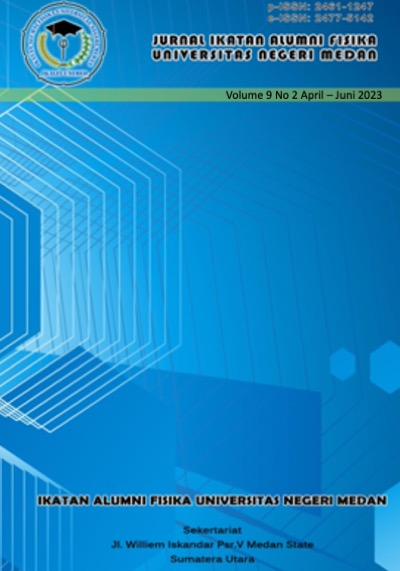PENGEMBANGAN VIDEO EKSPERIMEN BERBASIS PROBLEM BASED LEARNING (PBL) PADA MATERI PEMUAIAN ZAT PADAT DI SMAN 1 DOLOK BATU NANGGAR
DOI:
https://doi.org/10.24114/jiaf.v9i2.36720Keywords:
Experimental Video, 4D, PBL, Adobe Premiere Pro, Solids ExpansionAbstract
ABSTRAKPenelitian ini bertujuan untuk mengembangkan media video eksperimen yang layak untuk diterapkan dalam proses pembelajaran fisika, mengetahui respon pengguna terhadap media pembelajaran yang sudah dikembangkan dan mengukur keefektifan media pembelajaran dalam peningkatan pemahaman konseptual peserta didik. Subjek dalam penelitian ini adalah 40 orang peserta didik SMA Negeri 1 Dolok Batu Nanggar. Jenis penelitian ini merupakan penelitian pengembangan atau Research and Development (R&D) menggunakan model 4-D. instrumen yang digunakan dalam penelitian ini terdiri dari angket uji kelayakan ahli materi dan ahli media, angket respon guru bidang studi dan peserta didik serta soal pretest-posttest. Berdasarkan hasil analisis data uji kelayakan, diperoleh validasi dosen ahli materi sebesar 94,5% dengan kriteria sangat layak, validasi ahli media sebesar 97,5% dengan kriteria sangat layak. Hasil respon guru fisika SMA Negeri 1 Dolok Batu Nanggar yaitu sangat layak dengan presentase 98%. Respon peserta didik pada uji coba kelompok kecil dengan responden 10 orang mendapatkan respon sangat baik dengan persentase 88,5%. Sedangkan pada uji coba kelompok besar dengan responden 30 orang mendapatkan respon sangat baik dengan persentase 88,5%. Berdasarkan perhitungan nilai gain, media pembelajaran termasuk dalam kategori tinggi dalam keefektifan meningkatkan pemahaman konseptual peserta didik dengan nilai 0,76. Dengan demikian, media video eksperimen yang dikembangkan layak diterapkan dalam kegiatan pembelajaran, terutama pada materi pemuaian zat padat.Kata kunci : Video Eksperimen, 4D, PBL, Adobe Premiere Pro, Pemuaian Zat Padat ABSTRACTThis study aims to develop experimental video media that are feasible to be applied in the physics learning process, find out the user's response to the learning media that has been developed and measure the effectiveness of learning media in increasing the conceptual understanding of students. The subjects in this study were 40 students of SMA Negeri 1 Dolok Batu Nanggar. This type of research is a Research and Development (R&D) using a 4-D model. Based on the results of the feasibility test data analysis, 94.5% of the validation of material expert lecturers was obtained with very feasible criteria, 97.5% validation of media experts with very feasible criteria. The results of the response of the physics teacher of SMA Negeri 1 Dolok Batu Nanggar are very feasible with a percentage of 98%. The response of students in a small group trial with 10 respondents received a very good response with a percentage of 88.5%. Meanwhile, in a large group trial with 30 respondents, it received a very good response with a percentage of 88.5%. Based on the calculation of the gain value, learning media is included in the high category in the effectiveness of increasing the conceptual understanding of students with a value of 0.76. Thus, the developed experimental video media is worth applying in learning activities, especially in solid substance expansion materials. Keywords: Experimental Video, 4D, PBL, Adobe Premiere Pro, Solids ExpansionReferences
Budiyono. (2009). Statistika untuk Penelitian Edisi ke-2. Surakarta: Sebelas Maret University Press.
Megalina, Y. (2019). Penggunaan Media Video Eksperimen Berbasis Pendekatan Saintifik Terhadap Hasil Belajar Mahasiswa Pada Mata Kuliah Fisika Umum. Jurnal Ikatan Alumni Fisika Universitas Negeri Medan, 5(4): 1-5. http://doi.org/10.24114/jiaf.v5i4.15295.
Rahma, U. (2019). Skripsi Pengembangan Video Eksperimen Berbasis Saintifik pada Materi Gerak Harmonik Sederhana di SMA. Medan: FMIPA Unimed.
Sani, R.A., Manurung, S.R., Suswanto, H. & Sudiran. (2018). Penelitian Pendidikan. Tangerang: Tira Smart.
Siahaan, M. (2019). Dampak Pandemi Covid-19 Terhadap Dunia Pendidikan. Jurnal Kajian Ilmiah (JKI), (1): 1-3. Diakses dari http://ejurnal.ubharajaya.ac.id/index.php/JKI.
Sujana, A. & Sopandi, W. (2020). Model-Model Pembelajaran Inovatif : Teori dan Implementasi. Depok : Rajawali Pers.Geometris. Jurnal Kumparan Fisika, 2(2): 91-98.
Yanti, R.I & Sahyar (2022). Pengembangan Video Eksperimen Berbasis Saintifik Pada Materi Elastisitas dan Hukum Hooke di SMA. Jurnal Inovasi Pembelajaran Fisika (INPAFI), 10 (1). Diakses dari http://jurnal.unimed.ac.id/2012/index.php/inpafi.
Downloads
Published
Issue
Section
License
Copyright (c) 2023 JURNAL IKATAN ALUMNI FISIKA UNIVERSITAS NEGERI MEDAN

This work is licensed under a Creative Commons Attribution 4.0 International License.
Authors who publish with this journal agree to the following terms:- Authors retain copyright and grant the journal right of first publication with the work simultaneously licensed under a Creative Commons Attribution License that allows others to share the work with an acknowledgement of the work's authorship and initial publication in this journal.
- Authors are able to enter into separate, additional contractual arrangements for the non-exclusive distribution of the journal's published version of the work (e.g., post it to an institutional repository or publish it in a book), with an acknowledgement of its initial publication in this journal.
- Authors are permitted and encouraged to post their work online (e.g., in institutional repositories or on their website) prior to and during the submission process, as it can lead to productive exchanges, as well as earlier and greater citation of published work (See The Effect of Open Access).

